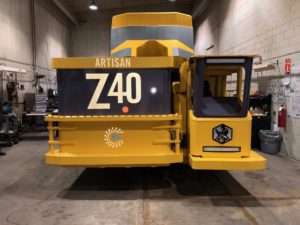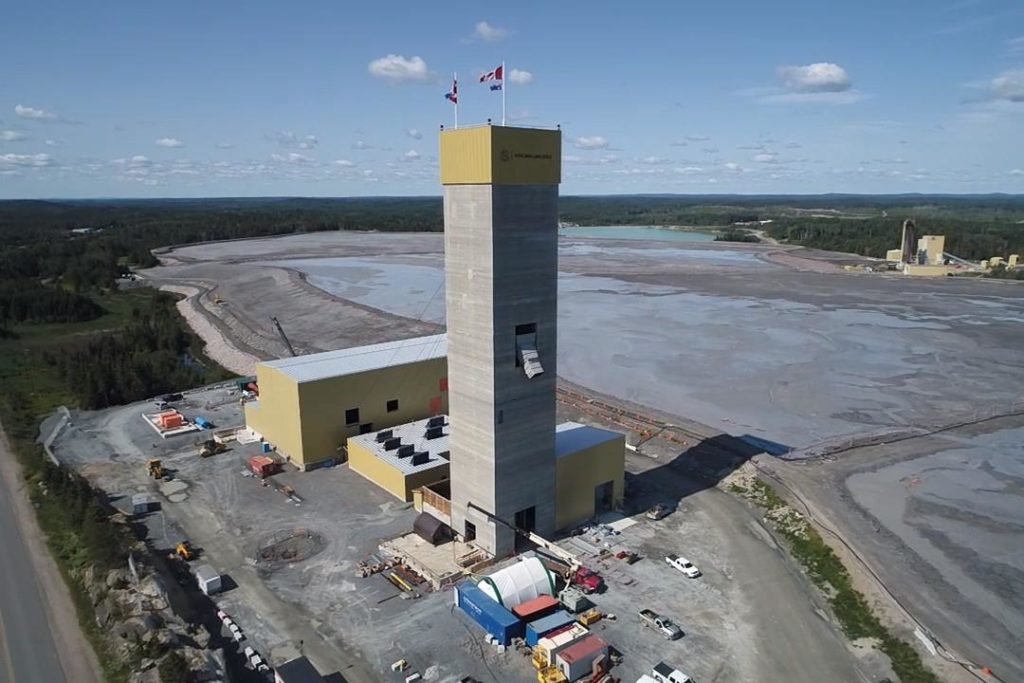As outlined in its just released 2021 Sustainability Report, Kirkland Lake Gold is a recognised leader in greenhouse gas performance, including one of the lowest GHG intensities in the industry. “We empower sites to develop and implement actions to reduce emissions and increase energy efficiencies, by improving electricity efficiency, implementing low-carbon technologies and using clean energy sources. Lowering emissions and improving our energy efficiency provides us with cost savings and environmental benefits within and beyond our operating boundaries.”
A big part of this in relation to Scope 1 emissions was and is its pioneering approach in implementing battery electric equipment underground. KL Gold has been leading the industry in greenhouse gas reduction since 2012. “We were the first to introduce battery electric vehicles in our operations and in 2020, commissioned the world’s first 50 t battery electric truck for use underground. Being a leader in such innovation came with challenges that we are still investing in to pave the way to making the technology commercially viable for our peers. We are below industry benchmarks on emission intensity on greenhouse gases and look to reach net zero by 2050 at the latest by investing towards greenhouse gas reduction and innovation.”
Tony Makuch, President and Chief Executive Officer of KL Gold adds: “The Macassa Mine is really the only mine in Ontario and Canada where most of its production facilities are powered with battery-operated equipment…we had to wait for the industry to catch up. And for the supply industry to catch up, we would have to wait a number of years. We decided we’ll be the guinea pigs. We’ll take the prototypes.”
In 2011, the Macassa Mine was an early adopter of the battery electric movement with electric scoops being deployed at the underground operation. The Macassa Mine now utilises 22 battery electric LHDs and six trucks. Notably, in 2019 the mine commissioned the world’s first zero-tailpipe-emission 40 t truck underground, which was built in partnership with KL Gold. “Being an early adopter, we were able to suggest many design improvements and provide feedback on the first prototype. This will help make this technology more commercially viable for other operations and the industry as a whole. Zero-tailpipe-emission vehicles, such as the Z40, are a critical part of Macassa Mine’s greenhouse gas intensity performance, which at 0.06 t CO2e per ounce of gold produced is amongst the lowest in the industry.”
The Macassa battery electric fleet includes Epiroc ST7 Battery, ST2G Battery, RDH (now part of SMT Scharf) EB300, Artisan (now part of Sandvik) A4 and A10 models of LHDs plus Artisan Z40 and Z50 as well as Epiroc MT2010 Battery trucks. However, despite the mixed fleet nature in terms of models, the mine uses 100% Artisan batteries and drive systems with purpose built cut out swapping bays.

Mining at Macassa is conducted primarily via overhand and underhand cut-and-fill and a small portion of long hole methods. All stopes are backfilled with either paste fill, cemented rock fill or loose waste rock. The main current development at the mine is the #4 Shaft Project, a new, 21.5 ft diameter, concrete-lined shaft which will offer a number of important benefits to the mine, including de-risking the operation; enabling more effective underground exploration to the east of the South Mine Complex; improving ventilation and general working conditions in the mine; and supporting higher levels of production and lower unit costs. The new four-compartment shaft will have a total hoisting capacity of 4,000 t per day (ore and waste) and is an important component of the company’s plan to increase production at Macassa with a goal of reaching over 400,000 oz per year. Construction of the shaft is being completed in two phases. The first phase is to a depth of 5,450 ft and include a mid-shaft loading pocket. Completion of phase one is targeted for the second quarter of 2022 at a capital cost estimated at C$240 million. Phase two of the project will be undertaken following the commencement of production from phase one, and will involve extending the shaft to an ultimate depth of approximately 7,000 ft. Completion of phase two is targeted for the end of 2023 at an estimated capital cost of approximately C$80 million.
Macassa Mine Second Life Battery Program
Macassa Mine has been operating Battery Electric Vehicles (BEVs) since 2011 to mitigate the economic and environmental effects associated with the operation of a diesel fleet underground. “Being an early adopter of the battery electric fleet, our batteries are ahead of the curve in reaching their end of life. To date, many battery packs have been retired and replaced due to infrastructure and performance demands. Despite this, the Lithium Iron Phosphate cells within these retired packs still have potential to be useful in other on-site applications. In 2020, 400 of these retired cells were tested and it was determined that 60% of the batteries were adequate to serve in other applications, such as energy storage systems to offset peak power demands. The Second Life Battery Project was initiated to perform testing and investigation of secondary uses of these spent batteries instead of sending them to landfills. This initiative has gained wider support and also has received a C$250,000 grant from the Northern Ontario Heritage Fund Corporation, which is aimed at building a battery energy storage system (BESS) from cells that are no longer able to be used by BEVs underground.”
Trialling biodiesel at Detour Lake
In 2020, KL Gold operations direct emissions (Scope 1) were 279,000 t of CO2e or 64% of its total emissions during the year. Emissions intensity per ounce of gold produced increased during 2020 to 0.32 t CO2e per ounce of gold produced, which is 67% lower than the WGC average. As part of our commitment to utilising clean energy sources, KL Gold plans to investigate the potential to introduce solar, biodiesel and hydrogen fuel cell energy sources at its operations. “We are committed to transparent disclosure of our impacts, and as part of this, we plan to respond to the CDP carbon questionnaire in 2021.”
One of the immediate advantages of having surface gold mine Detour Lake as part of KL Gold was the sharing of best practices from each respective site. “As Detour Lake Mine is a large open pit operation, the use of surface diesel trucks is prevalent. Since Macassa Mine has experience in the use of biodiesel blends at their operations, that knowledge was brought over to Detour Lake Mine to pilot biodiesel blends on a select few of our mid-sized support equipment. The logistics of biodiesel purchase, storage and use were quickly developed with collaborative efforts from both Detour Lake Mine and Macassa Mine. Although the colder weather proved challenging for the initial biodiesel blend, the teams have not given up on biodiesel, or on looking for alternatives to reduce GHG emissions. A positive from this trial is it has formed a cross-site collaborative culture for innovation and we look forward to what’s to come.”











